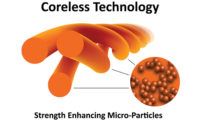We’ve talked a lot in the past few years about the bad old days of stiff, bulky cut-resistant gloves as we introduced you to the next generation of gloves, sleeves, and cut-resistant clothing. New products and new technologies with unique yarn blends, coreless yarn with strength-enhancing microparticles, and special fabric weaves brought you a whole new level of cut, abrasion, and puncture protection without the bulk or stiffness. Manufacturers are also adding and combining these materials with features like specialty glove coatings and impact protection that keep workers safer, cooler, and more comfortable in just about any environment.
Extreme cut protection in feather-light materials
The fundamentals of cut-resistant yarns haven’t changed. Most are created with one or more inner core materials, surrounded by an outer wrap. Special methods of yarn wrapping can also provide higher cut resistance.
Now new yarn blends are stronger and more flexible than stainless steel, are changing the game by creating incredibly light cut-resistant fabrics.
While comfort is important to keep workers happy and compliant, the features of this new technology provide additional benefits that keep employees safer. First, they allow workers to pick up and manipulate very small parts while wearing them, so they can do the whole job while staying protected. Couple that with the comfort that a lighter glove provides along with touchscreen compatibility, and you eliminate the problem of workers who remove their gloves to complete a task or give their hands a break — and too often leave them off!
Extreme cut protection for oily applications
It can be hard to find the right protection when your application involves heavy liquids or oils in addition to handling sharp materials. Even a light and comfortable cut-resistant glove won’t be ideal to wear if it’s soaking wet or saturated with oil. Some industries turn to double-gloving to solve the problem with a water-resistant glove against the hand and a cut-resistant glove over it. But this can be expensive, and it can compromise grip as one glove slips against the other. Many gloves are dipped in special coatings to help with the problem, but this too can come with its own set of issues in oily environments. While some coatings help to repel oil to keep hands drier, they make for a slippery grip as the palm becomes coated and slick with oil. Other coatings have oil absorbing qualities, but they become saturated quickly, leaving hands slick and uncomfortable inside the glove.
New glove coating technology solves both problems. Technology has the added benefit of higher abrasion resistance with protection as high as A7. So you get all the other oil-handling benefits of its predecessors and the lightness that allows workers to easily pick up small, oily parts without removing their gloves.
Extreme cut protection for impact hazards
Back in the day, impact gloves were particularly cumbersome with a stiff, bulky thermoplastic rubber (TPR) polymer across the back of the hand and fingers. New technologies added flex points in the TPR at the backs of the hands allowing workers to move and stretch their hands naturally, along with special mesh backs and vented TPR to provide better airflow in a cooler, more comfortable glove.
Manufacturers have been able to combine innovations so it’s now possible to get cut resistance as high as ANSI A9 along with flexible, cool impact protection. And for applications like heavy assembly work that may involve the trifecta of high cut hazards, impact hazards, and heavy liquids or oils, they combine all of the above.
The best news with these evolving technologies is that innovation never stops. Gloves and other gear that keep people comfortable and prevent them from overheating in very hazardous conditions are an incredible benefit for industrial safety. But new technologies are on the horizon that may do even more to keep workers’ hands and arms cool in the hottest conditions as they protect them from other hazards like flames, cuts, abrasions, and impacts.



